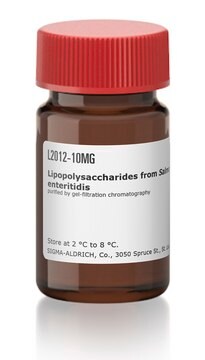L8643
Lipopolysaccharides from Pseudomonas aeruginosa 10
purified by gel-filtration chromatography
Synonym(s):
LPS
Sign Into View Organizational & Contract Pricing
All Photos(1)
About This Item
Recommended Products
biological source
Pseudomonas aeruginosa (10)
Quality Level
form
lyophilized powder
purified by
gel-filtration chromatography
impurities
<3% Protein (Lowry)
color
white to faint yellow
solubility
water: 4.90-5.10 mg/mL, cloudy to hazy, colorless to faintly yellow
storage temp.
2-8°C
Looking for similar products? Visit Product Comparison Guide
Application
Lipopolysaccharides from Pseudomonas aeruginosa 10 has been used as an inflammatory mediator in cells.
Lipopolysaccharides (LPSs) are characteristic components of the cell wall of Gram-negative bacteria. LPS and its lipid A moiety stimulate cells of the innate immune system by the Toll-like receptor 4 (TLR4), a member of the Toll-like receptor protein family, which recognizes common pathogen-associated molecular-patterns (PAMPs).
Other Notes
To gain a comprehensive understanding of our extensive range of Lipopolysaccharides for your research, we encourage you to visit our Carbohydrates Category page.
related product
Product No.
Description
Pricing
Storage Class Code
11 - Combustible Solids
WGK
WGK 3
Flash Point(F)
Not applicable
Flash Point(C)
Not applicable
Personal Protective Equipment
dust mask type N95 (US), Eyeshields, Gloves
Choose from one of the most recent versions:
Already Own This Product?
Find documentation for the products that you have recently purchased in the Document Library.
Customers Also Viewed
Coordinate induction of two antibiotic genes in tracheal epithelial cells exposed to the inflammatory mediators lipopolysaccharide and tumor necrosis factor alpha.
Russell JP
Infection and Immunity, 64, 1565-1565 (1996)
Clara cells attenuate the inflammatory response through regulation of macrophage behavior.
Snyder JC
American Journal of Respiratory Cell and Molecular Biology, 42, 161-171 (2010)
Sandra Chang et al.
PloS one, 10(7), e0131810-e0131810 (2015-07-07)
Oxidant production from DUOX1 has been proposed to lead to neutrophil recruitment into the airways when lung homeostasis is compromised. The objective of this study was to determine whether DUOX-derived hydrogen peroxide is required for LPS-induced neutrophil recruitment, using a
Macrophages directly contribute to the exaggerated inflammatory response in cystic fibrosis transmembrane conductance regulator-/- mice.
Bruscia EM
American Journal of Respiratory Cell and Molecular Biology, 40, 295-295 (2009)
Austin Boucher et al.
Journal of immunology (Baltimore, Md. : 1950), 206(3), 540-553 (2020-12-18)
Macrophages are critical for regulating inflammatory responses. Environmental signals polarize macrophages to either a proinflammatory (M1) state or an anti-inflammatory (M2) state. We observed that the microRNA (miRNA) cluster mirn23a, coding for miRs-23a, -27a, and -24-2, regulates mouse macrophage polarization.
Our team of scientists has experience in all areas of research including Life Science, Material Science, Chemical Synthesis, Chromatography, Analytical and many others.
Contact Technical Service


